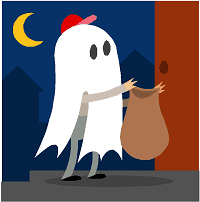
Of all the holidays that we celebrate each year, Halloween is the one with the greatest potential for sparking the imagination. Kids (and let’s be honest, quite a few adults, too) are thinking about the costume they’ll wear, long before the actual night. And it’s easy to get everyone excited about making fun decorations for the classroom and elsewhere.
Witches, goblins, superheroes, and cartoon characters meet Jack o’Lanterns, fangs, and zombies in a festival of the unreal and the fantastic. (Not to mention all the free candy!) It’s the perfect opportunity to round up some of that bubbling excitement, and turn it into poetic fun! Here are a few ideas for the Scary Season, activities that are easily adaptable for most age-groups.
Mini-Poems for Maximum Effect
For many children, the thought of being ‘forced’ to write a poem is terrifying, and not in a fun, Halloween way! The empty page is just as scary for them as it would be for you, if you were suddenly asked to come up with some funny, clever lines to read out loud in the staff room. One of the easiest ways to break the creative ice is to give an assignment with very clear parameters, such as writing short poems like limericks or haikus. You’ll need several examples, which you can easily find on the net or even write yourself. But the most effective way to both explain the form and get kids enthusiastic is to write a few together in class. Let the students suggest elements, such as a character (a witch, a fairy, Superman and so on) or a place name (your town, New York, etc), and then begin writing the poem on the blackboard.
Remember that you’re not aiming for world-class, quality writing here! As long as the poem is true to the form and makes sense, you’re doing well. If it’s also funny, so much the better. If kids are yelling out their versions of lines that could work, then you’ve completely succeeded.
Limericks and haiku’s each have their good and bad points, of course. Haiku may well be easier for many kids, but it’s less likely to result in the engaging silliness that makes limericks so much fun. Limericks, on the other hand, are harder to write. Because of this, one poetic form I often recommend is the “clerihew.” Don’t worry if you’ve never heard of a clerihew, I have a lesson with several examples in the Poetry Lessons section of this website.
You might even consider having a “Halloween Idols” competition for the poems, allowing the kids to vote for their favorite, with a small prize for the winner.
No Writer’s Block in this Classroom!
There are so many different themes that can be used for Halloween, which makes it all the more frustrating to hear the refrain, “What should I write about?” Nevertheless, it is this initial decision that stymies children, especially those who haven’t had much exposure to creative writing. You can use this to your advantage, by first having a topic brainstorm. Give each pupil three small pieces of paper (or as many as you think they can manage) and ask them to write one topic idea on each one. For very young students, it is enough to write down simple nouns, such as ‘monster’ or ‘Batman’. For those in higher grades, it can be tremendous fun to come up with combinations, such as ‘a witch called Nibblenose who only eats Cheerios’. Gather up the pieces of paper in a bag, shake them up, and then let each student pick three. They can then choose any of those topics, or one of their own, if they wish.
Writing poems can also work very well as a group activity. Have kids write in teams. When they are done, add a poster, a costume and a performance, and you have an entire Halloween project.
Lastly, if your class gets really carried away with the fun of it all, you have the option of a class assignment, to create a little book of Halloween poems, illustrated by the kids. Who knows? You may even be able to turn that into a PTO fund-raiser, if you have a willing parent with good printing and binding capabilities, or even using a free “print-on-demand” service like Lulu.com. Alternatively, the class can create a Halloween poetry blog, where they can post their poems and pictures, and then share them with family members at home. After all, that’s where poetry really comes to life – when it’s shared.






